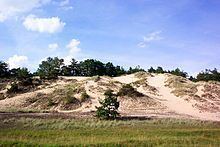 | ||
Formation
In Central Europe, towards the end of the Vistula or Würm Ice Age, it was about 10 degrees colder than today. There was therefore no forest cover but only patchy vegetation in the form of tundra. In addition, in the areas covered by the ice sheet, the vegetation had to re-establish itself as the glaciers melted. As a result, the winds could blow almost unhindered. Light, fine-grained soil particles, especially of silt and sand were plucked up by air currents, often transported for miles and then deposited at another location. The wind also had a sorting effect - silt is transported significantly faster than sand - and this resulted, over time, in areas of aeolian sand and sand dunes being formed, while the silt was transported much further and redeposited, for example, on the northern edge of highlands.
In high winds the dunes had a tendency to "wander". Most of the currently existing inland dunes were created at this time. With the end of Ice Age, the mobility of the dunes quickly came to a halt as a result of reforestation.
The shape of inland dunes varies depending on the prevailing wind direction and strength. Most of them are rather irregular dunes or shifting belts of sand. But there are also occur very well-formed parabolic dunes and longitudinal dunes.
Nearly all recent phases of the development of inland dunes are affected by human intervention on the vegetation cover. By the deliberate or unintentional clearing of the forest, dunes became mobile again in areas where they had become static.
The analysis of charcoal particles in the dunes using radiocarbon dating has established that the activity of settlers in the Neolithic period caused the dunes to become mobile again. But even in the Bronze and Iron Age there is evidence of man-induced dune activity.
North America
The sands of the inland dunes of El Vizcaíno Desert, Baja California, Mexico, come from nearby alluvial sources. Originally the sands are thought to have derived from granitoids, schists as well as sedimentary and volcanic rocks. While composition suggest that dune sands come from a craton setting geochemistry indicates an active continental margin setting for the origin of the sand.
South America
Near Copiapó in the southern reaches of the Atacama Desert the largest dunes of Chile exists. Based on an analysis of sediments it has been suggested that the dunes derive from fluvial sediments. A previous explanation suggests that the dunes originated from coastal sand in marine terraces that were uplifted, then deflation would have caused this sand to migrate inland. At present the dunes are active but starved of sediment supply.
Inland dunes in the Gran Chaco of Bolivia and Paraguay are concentrated at the Andean foothills. Most of these dunes are inactive with some being as old as 33–36 thousand years old.
Europe
Within Central Europe, therefore, inland dunes exclude the belts of coastal dunes on the North Sea and Baltic Sea coasts. Unlike their coastal cousins, inland dunes are aeolian formations of sand (dunes) transported and then deposited by wind. They were predominantly created under cold climatic, periglacial conditions at the end of the Weichselian and Würm ice ages, i.e. roughly more than 10,000 years ago. Their development during the post-glacial period has been heavily influenced by mankind.
In northern Sweden numerous inactive dunes exists. These dunes were formed in a Holocene periglacial context when the Weichsel Ice Sheet was retreating. At present smaller parabolic dunes are forming in northern Sweden due to redeposition of deflated dunes. As recorded by dune stratification the wind the formed the larger and older dunes blew from northwestern directions.
